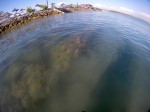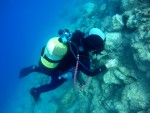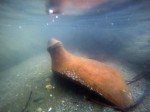 A team of international researchers has found that an ancient Roman port in Albania is much larger than archaeologists realized. Led by Peter Campbell of the University of Southampton and Neritan Ceka of the Albanian Institute of Archaeology, the expedition’s aim was to assess the ecological health of the coastal waters and the condition of submerged archaeological sites from Butrint on the southern tip of the country near the border with Greece, north along the Adriatic to the Bay of Vlorë.
A team of international researchers has found that an ancient Roman port in Albania is much larger than archaeologists realized. Led by Peter Campbell of the University of Southampton and Neritan Ceka of the Albanian Institute of Archaeology, the expedition’s aim was to assess the ecological health of the coastal waters and the condition of submerged archaeological sites from Butrint on the southern tip of the country near the border with Greece, north along the Adriatic to the Bay of Vlorë.
 The remains of the ancient city of Triport are for the most part submerged in the waters near the modern port city of Vlorë. It was first discovered by archaeologists in the 1920s who documented Greek and/or Roman stone structures including the beginnings of a large wall and a road. Surveys in the 1970s and 80s discovered an ancient fortress and its defensive walls. It was inhabited from the 6th c. B.C. to the 2nd A.D.
The remains of the ancient city of Triport are for the most part submerged in the waters near the modern port city of Vlorë. It was first discovered by archaeologists in the 1920s who documented Greek and/or Roman stone structures including the beginnings of a large wall and a road. Surveys in the 1970s and 80s discovered an ancient fortress and its defensive walls. It was inhabited from the 6th c. B.C. to the 2nd A.D.
The structures were initially thought to be part of the supportive infrastructure of the port. Later investigations found that the large walls originally encircled the lower city. When sea levels rose, the port and lower city were submerged. Archaeologists have mapped about 12 acres of the site over the past century. This season divers found an additional eight acres of ancient structures under water.
The results suggest Triport was a harbour for a large settlement during the Roman period, perhaps associated with the ancient city of Aulon (now Vlora). Triport offered ships safe anchorage in both the sea and Narta Lagoon, and connected to ancient cities like Aulon and Apollonia through major Roman roads. […]
Peter Campbell comments: “We found indicators of ancient sea level change, Greek and Roman trade (4th BC – 7th AD), and contemporary environmental data. But one of the most significant discoveries was the larger submerged remains – prompting us to rethink the importance of Triport as a Roman harbour.
“Albania has some of the most important waters in the Mediterranean. This coastline was vital for ancient trade and it continues to be significant as the convergence zone for species from the Adriatic and Ionian seas.”
 The survey discovered copious evidence of the long history of active trade along the Albanian coastline. Amphorae, bellwethers of trade in the Mediterranean thanks to their eminently datable styles, have been found dating from the Hellenistic Period through the early Middle Ages. There are anchors galore, made of stone, lead and iron. The team also found common consumer goods like dishware, water jugs and imbreces and tegulae (curved and flat roof tiles). The artifacts were not recovered, but left in situ for future explorations.
The survey discovered copious evidence of the long history of active trade along the Albanian coastline. Amphorae, bellwethers of trade in the Mediterranean thanks to their eminently datable styles, have been found dating from the Hellenistic Period through the early Middle Ages. There are anchors galore, made of stone, lead and iron. The team also found common consumer goods like dishware, water jugs and imbreces and tegulae (curved and flat roof tiles). The artifacts were not recovered, but left in situ for future explorations.
What was retrieved from the ancient underwater structures is even more valuable than amphorae and anchors: information that illuminates the history of coastal shifts.
Ancient archaeological sites such as cities, harbour structures, and quarries around southern Albanian showed submergence up to 150 cm, due to a number of geological processes. Peter Campbell comments: “The Albanian coast is incredibly dynamic and we have found excellent indicators of sea-level change such as tidal notches to sunken cities and harbours. This lets us reconstruct the coast in the past, which tells us how different parts are changing through time and may change in the future.”
[youtube=https://youtu.be/zwJd8m6zxm0&w=430]